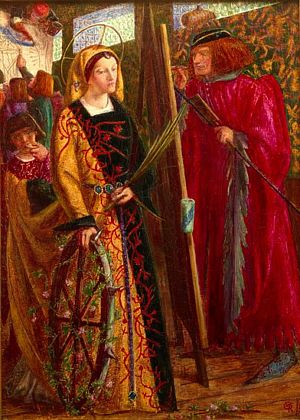Skilled Child Molestors
Before becoming a Romance Coach, before meeting my Sweetheart Drew, before I moved to Florida, I lived on the Maine coast and had a mental health private practice in Blue Hill, a classically picturesque village. Now Drew and I are going to be living in the area summers, and I am picking up on old friendships. That means dinner parties, and at a recent one, I heard about the existence of a sexual predator in Blue Hill who had been recently exposed in the press. This man was well-known in the community, and the revelation has been shattering. When they told me who it was, I was pretty shaken myself.
The stories that the assembled guests told were confusing and conflicting, so the next day, I went to the Blue Hill library and read all the local papers for the past year, tracing the coverage. And I did a trusty Google search which yielded even more information. I’ve copied below the excellent article from the Bangor Daily News. The local Blue Hill paper, the Blue Hill Packet, is not accessible online.
While this case and the coverage has nothing to do with Internet dating, it does have to do with the skilled sexual predator, which unfortunately, single women (and some men) looking for mates online and off need to watch for: People (usually men) who hook up with vulnerable women who have children they can abuse. My next blog posting will be more to the point, but this is very interesting reading. Frankly, I have never seen anything like it.
Blue Hill group confronts effects of sexual abuse through education, support for victims
Wednesday, March 28, 2007 - Bangor Daily News
Tucked safely into a craggy coastline that has been an inspiration to centuries of artists and boat builders, Blue Hill seems to be a town with everything. It has good schools, excellent restaurants, breathtaking views of Mount Desert Island, a renowned summer music school and a mountain that serves as a landmark to hikers on far-flung trails. Unlike many small towns in Maine, more than a quarter of the households in Blue Hill have children under the age of 18.
But on Thursday nights, some residents of this seemingly idyllic locale and beyond meet in the basement of the Congregational church to discuss a far less attractive aspect of their community life: pedophilia. The group began meeting in February after a single mother in the area pulled her son out of Liberty School, a project-based experimental high school, because she suspected that an almost two-year relationship between her 17-year-old boy and his 63-year-old mentor had gone dangerously awry.
Her fears were fed when a neighbor gave her an apologetic letter the mentor had written more than 10 years earlier acknowledging his sexual misconduct with another teen boy. Her panic was compounded by a civil suit, filed in Hancock County in December 2006 on behalf of a Rhode Island resident, accusing the same man of sexual abuse in 1994 when the plaintiff was 10 and 11. When the Blue Hill group met last week, two other men in their 20s spoke of uncomfortable encounters and feelings of betrayal regarding their relationships with the man and his wife. One man drove from Massachusetts to attend the group; another from Portland.
“When you have those gut feelings, trust them,” said the single mother, who asked not to be identified. “I had them in the beginning, and I didn’t act. There’s so much I didn’t know to be aware of. I’m thrilled this community is committed to making this community safe and preventing any more harm.”
The aim of the group, say its ardent and in many cases angry organizers, is to support local victims of child sexual abuse and to hold sexual offenders accountable for their actions and the pain they cause both their victims and their communities. Other towns have lashed out against sex offenders released into their midst. Blue Hill is trying to instigate justice in a more complex way.
To a large degree, the members meet to share information about Maine laws, to discuss known patterns and myths about sexual offenders, and to collate their impressions, research and concerns about their town. While the members of the group are in favor of legal justice, they also see the power of citizen awareness in combating threats that arise in their own backyards and under their own roofs. Informed by the practices of restorative justice, which emphasizes repairing the harm done by criminal behavior, the neighbors are not out to “string anybody up,” as one member put it.
“I’m trying to uncover the truth,” said Mary Offutt, one of the group’s most vocal members. She has spent many hours making phone calls, writing letters, photocopying legal documents and circulating books among neighbors.
The truth as this group knows it involves Howard Evans and Vicki Pollard, who also is named in the civil suit for breach of duties to a minor. The two have been regarded as community pillars and, because each is a practicing acupuncturist, as healers. Evans was once director of Haystack Mountain School of Crafts, and has been an active and respected participant at town meetings, on local boards, in school events, at the town’s vibrant food cooperative and at a nearby Zen meditation center. For more than 20 years, he has been a godfather, mentor and inspiration to more than a few young men, some of whom now say they are worried his warmth and openness might have been more sexualized than they realized then, and who now wish Pollard had intervened. Their anger at a meeting last week was raw and determined.
From the start, the group has sought the guidance of Jon Wilson, founder and director of a nonprofit victim support program, Just Alternatives in Brooklin. Wilson is best known for founding WoodenBoat magazine and the WoodenBoat School also in Brooklin. In recent years, he has trained and worked in victim-centered practices with correctional facilities.
“My work is on behalf of victims and survivors who want to meet their offenders,” said Wilson, who moderates the discussions Thursday nights. “I believe that what offenders need and, deep down, want is to be held accountable. Therefore, I believe the greatest thing we can do is to enable victims to be heard and to enable offenders to hear with the greatest sense of safety. The only way to do that is to have the offender’s trust. The only way to do that is to hold the offender in unconditional human regard. I can think that what he has done is monstrous. But he is not a monster. He is a human being.”
Emotions can run high at the meetings, but, seated in a circle, members who range from teens to senior citizens speak calmly and candidly about their experiences. Their reasons for attending are as varied as their professions. Doctors, artists, educators, writers, ministers, contractors, therapists, farmers and builders attend out of a sense of solidarity with victims or determination for child safety, as well as out of curiosity and confusion.
Others in the area said they would attend only if Evans and Pollard were also in the circle. Neither has attended the meetings. In a phone call last week, Evans said he was “not at liberty” to speak about his community or about the group. On Tuesday, Pollard said she was “not available to speak” with the press.
Organizers maintain that the meetings are open to anyone who wants to listen to victims and understand sexual abusers. Its members also have turned an examining eye inward. Several, including Wilson, hold themselves responsible for keeping secrets about experiences in their own past, confrontations they say they had but never mentioned for fear of being ostracized or because they wanted to protect their own reputations, because they doubted their own intuitions or because they wanted to believe in the goodness and honesty of others.
But experts agree that silence is a pernicious player in the sexual offender drama.
“It’s the quietness that has allowed this to go on,” said Carla van Dam, a clinical and forensic psychologist in Olympia, Wash., and author of “The Socially Skilled Child Molester,” a book that identifies common patterns of molesters. It has become the unofficial bible of the Blue Hill group. “We have occasional cases that grab the headlines, but for the most part communities go on keeping secrets, protecting offenders and leaving kids out to hang. When someone steals a child’s bicycle you feel no shame in telling your neighbors or telling them to keep their eyes open for more theft. When a child is molested, everyone keeps quiet including the victim because they feel ashamed. It’s an attitude problem. And who does it really protect? The offender.”
The difference, in part, is that a bike is a real object and everyone can agree on its existence. When it comes to sexual misconduct, as the Blue Hill group is finding, detection, identification, memory and personal certainty all can be elusive.
Until the truth is known, however, cautious steps have been taken. Liberty School has revoked Evans’ mentoring position, and its acting president, Scott Pusey, attends the Thursday meetings. Other local organizations have made changes, too. Evans has been asked to step down from his board position at the Morgan Bay Zendo, where he and Pollard led popular retreats. And he has voluntarily agreed to no longer work at the Blue Hill Food Co-Op where some customers said his presence made them uncomfortable. If wrongdoing has occurred, it is now contained by isolation.
But that is not enough for Blue Hill. Hugh Curran, a founder of the Morgan Bay Zendo, attended the discussion group twice. The first visit was informative, he said, but during the second one, he experienced such anguish listening to stories that he could not sleep that night. Yet he will return to the group, he said, because he believes in its idealism, that compassion starts with the victim, but doesn’t end there.
“You can’t just be insightful,” said Curran, a practicing Zen Buddhist. “You have to be insightful with compassion at the same time. It has to be that you do what you do for the betterment of the abusive person. The compassionate view is that to ostracize and separate, to make people an evil force would be counter to the meditative force we embrace here.”
Even that position has variations.
“People talk about a goal. What do you want? To put him in jail? Run him out of Blue Hill?” said Nat Bray, a survivor whose parents received the apologetic letter from Evans in 1996. Bray, now 39, runs a computer network company in the San Francisco area and is in touch with group members in his hometown.
“The thing that would make me happiest is for him to see this issue for what it really is, to stop denying the issue, to even become a player in the group,” said Bray. “If he were to have a change of heart, I think he could be an incredible voice that could really be heard. He’s smart and articulate and could become a huge asset in this. I mean, I don’t trust him, and he’d have to be monitored. But it really comes down to trying to resolve this. There’s a Buddhist expression: ‘Turn poison into medicine.’ It’s not just seeing a silver lining but creating something of value out of a bad experience.”
Given that child sexual offenders hold one of the lowest positions on the social ladder, these goals are more than idealistic. But they are not entirely unprecedented. Canada has made strides with a sex offender transitioning program called Circles of Support and Accountability by creating communities of volunteers for sex offenders to join after prison terms. In Ontario, about 100 circles meet from once a week to occasionally, each one tailored to the needs of a “core member” — the sex offender — and five to seven volunteer sponsors who help integrate the offender into community life.
“The roots are in restorative justice, which at its heart is intended to empower the community,” said Hugh Kirkegaard, a Baptist minister who co-founded the Ontario program 13 years ago. “People who are in this program have to understand the theft to the community before they can deal with the issues. This vision is about the community reclaiming a capacity to deal with conflict that, historically, would be dealt with in limited ways by the criminal justice system.”
But none of the experts interviewed for this article including Kirkegaard, Carla van Dam and officials at the Maine Department of Corrections had encountered a grass-roots group like the one in Blue Hill. More typically, they are familiar with angry residents who mobilize when a sex offender is released from prison into their neighborhoods, an approach that often can make the situation worse, the authorities say.
While citizen activism goes back to the very founding of this country, specialists in the field of sexual abuse say the Blue Hill group may be spearheading an innovative and promising — if untested — model for reducing sexual threats to children in communities with repeat offenders living in their midst. Presumably, the group’s work eventually would extend to five Blue Hill residents listed on the Maine Sex Offender Registry, too.
Denise Lord, associate commissioner for the Department of Corrections, described the group as “significant and positive community involvement. They’re able to try to take a community healing approach versus a more reactionary approach. In part, it seems driven by the fact that this is someone known to the community. If it were someone with less stature or someone less well known, would the community react in the same way? Knowing Blue Hill, I’d have to say the group might have responded the same way.”
Joseph Fitzpatrick, director of clinical services for the department, agreed. “Understanding offenders is probably more important than trying to keep them out of the community,” he said. “It’s not about a cure. It’s about successful management and reintegration. Some of what communities think they are doing to protect themselves has the opposite effect. There are approaches that are more insightful and protective of the community and that do reduce the risk. Education is the best thing any of us can do around this issue.”
And breaking the silence. Last April, when Tom Wallace, a 42-year-old choral director on Mount Desert Island, was convicted and imprisoned for molesting two 11-year-old boys, very little public conversation ensued. The choir disbanded. The community was shattered. And that does not take into account the aftermath for the victims and their families.
“What’s really, really important is to reach closure,” said a resident of the island who asked not to be named. “And I don’t think you can reach closure if you bury it or just grind it around. It’s important to have compassion — not only for the victims but for the perpetrator, and that does not mean glorifying him. But it is important to realize what a valuable person he has been in his other work in the community. It has to be addressed. That’s what this community is missing. We’re in pain for what happened and for not having the choir, but nobody here has dealt with it. So the door is closed.”
The work of the Thursday night group in Blue Hill is to deal with it. Their methods may have implications for more than one picturesque community of just over 2,300 residents. The goal is to protect the vulnerable and the victimized, and to prevent recurrence. The goal is also to heal as a community and eliminate the silence shadowing this taboo subject.
“How we deal with these kinds of situations in Blue Hill, Maine — it’s one end of the spectrum,” said Hugh Kirkegaard. “Our ability to be creative here determines our ability to deal with places like Iraq. It has to do with breakdown and how we deal with that in our community. Our experience says: Yes, communities can do this. The Circles [of Support and Accountability] experience is that we don’t have to be overwhelmed. We have the ability to respond in constructive and life-giving ways.”





